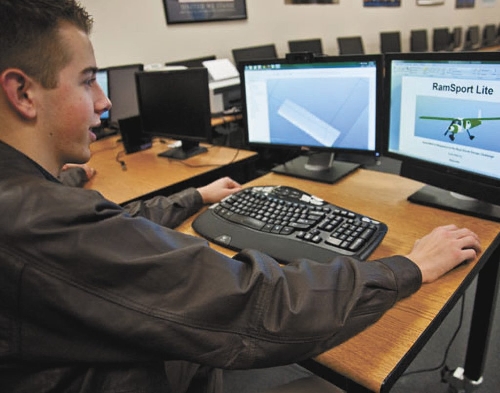This idea could fly: Students design all-electric plane
Because of seven local high school students, the Federal Aviation Administration is looking into regulations for something it's never had to certify -- an all-electric airplane.
A team of Rancho High School students has designed a two-person, light-sport plane that could cruise 1,000 feet high at 200 mph for more than two hours.
It would rely on an 81-horsepower electric motor, a lithium-ion battery similar to that in the Hyundai Sonata hybrid car, and wings covered with solar panels.
Through a little creativity, they've kept its takeoff weight at 800 pounds, which is 100 pounds lighter than a fueled Honda Goldwing motorcycle. They're toying with adding a second battery to almost double its range.
"It's a beautiful machine and looks like it would fly well," said Paul Siegmund, FAA certification engineer for commercial airplanes in Seattle.
The students' questions about rules for battery placement in an electric plane stumped him, so he took it up the ladder.
The team never intended to spur the creation of federal regulations, said 17-year-old Joshua Emig, who has been team leader since Gov. Brian Sandoval handpicked the school in October to represent Nevada in the Real World Design Challenge, which draws competition from high schools across the nation.
The annual competition -- put on by NASA, the U.S. Department of Defense, Lockheed Martin Corp., and others -- gives $1 million in aerospace engineering software to each high school team and presents a challenge. This year's was to design an environmentally friendly plane meeting specifications of a light-sport aircraft. This is a relatively new category approved by the FAA in 2004 for simple-to-operate, cheap planes.
Teams started with the fuselage of a Cessna 162 and had four months to come up with the most important parts: wings, a tail and drive train.
State champions will be announced this week and will be given another challenge on Monday that they must present in Washington, D.C., in late April for nationals.
Rancho's team has known from the start that it would be landing in Washington.
Sandoval picked only one team for the state's first try. Rancho, near Owens and Eastern avenues, was the natural choice because of its aviation pilot and engineering magnet programs, coach and aerospace teacher Gary Archambeault said.
But the team still had trouble getting off the ground. The problem -- school computers. Even when they persuaded the Clark County School District to buy a 64-bit Lenovo computer with double the processing power of the usual 32-bit, it took 20 hours to run just one wind-tunnel test.
"The RAM would be maxed out, but we'd still be getting nothing," said Emig, a tall, lean teen with a thin face and short, stiff hair. Add in his leather flight jacket (he's a licensed pilot), and his resemblance to "Top Gun" movie character Goose is uncanny.
The team combined the RAM, or data storage capacity, of four computers, but that barely helped. The district finally ordered two, liquid-cooled video-gaming computers last week, which should be here in time for nationals and can run a whole batch of wind-tunnel tests in four hours.
Though Archambeault was the coach and FAA's Siegmund was the mentor, the team did almost all of it alone, they said.
Emig split the team into committees, giving each a specific task based on their talents.
Melissa Mercado, a junior and physics whiz, and Chris Drake, a senior and engineer, had to find a motor. They pitched electric.
"I had to fight for it," said Drake, a 17-year-old senior. "Range is usually almost nothing."
They found an 81-horsepower motor, but it consumed more energy than a battery could provide to get them 200 miles in two hours. They found solar-paneled wings would provide the extra oomph they needed, and then some.
Most team members were given a role in designing and analyzing wing/tail designs, including Matthew Flores, Cameron Wall, Ian Stewart and Victor Santisteban.
They decided on wings made of a Kevlar epoxy composite, cutting the weight in half. Trying to explain the calculations that determined their design "dumbfounds" parents, Wall said.
"I've given up trying to explain to my mom," he said.
One of the few people that understands is Archambeault.
"My role is to guide them, but they've expanded beyond that," said the coach, who has been named by Sandoval as the Nevada coordinator of the Real World Design Challenge.
That means the governor plans on having more teams next year, Archambeault said. Not to mention, a first-ever automotive challenge has also been issued, but for only 50 teams nationwide. Rancho will take part and started work this week, he said.
Their task: Design an eco-friendly school bus. This team will be late out of the gates, but will be ahead in one way. Their computers won't crash.

















